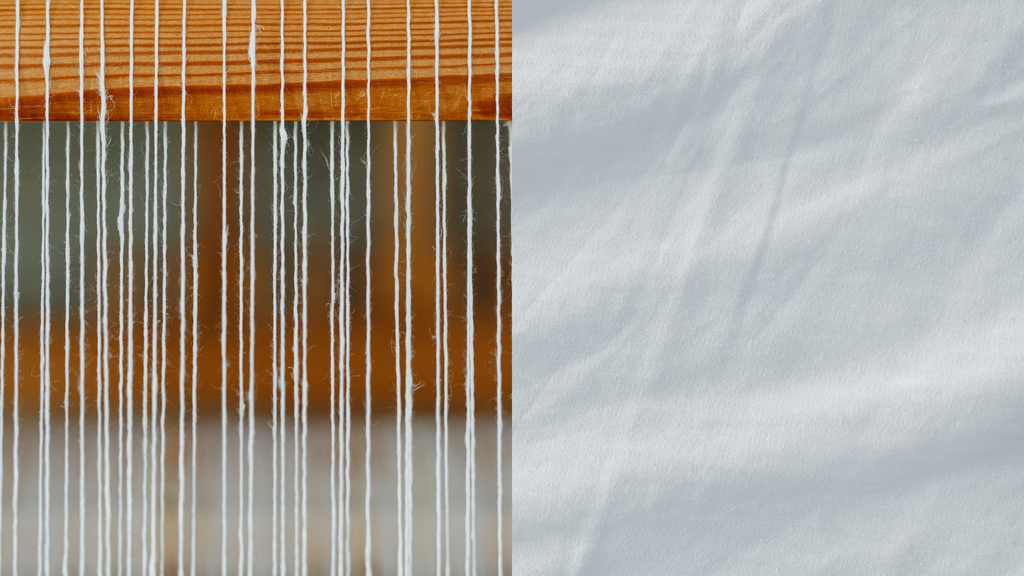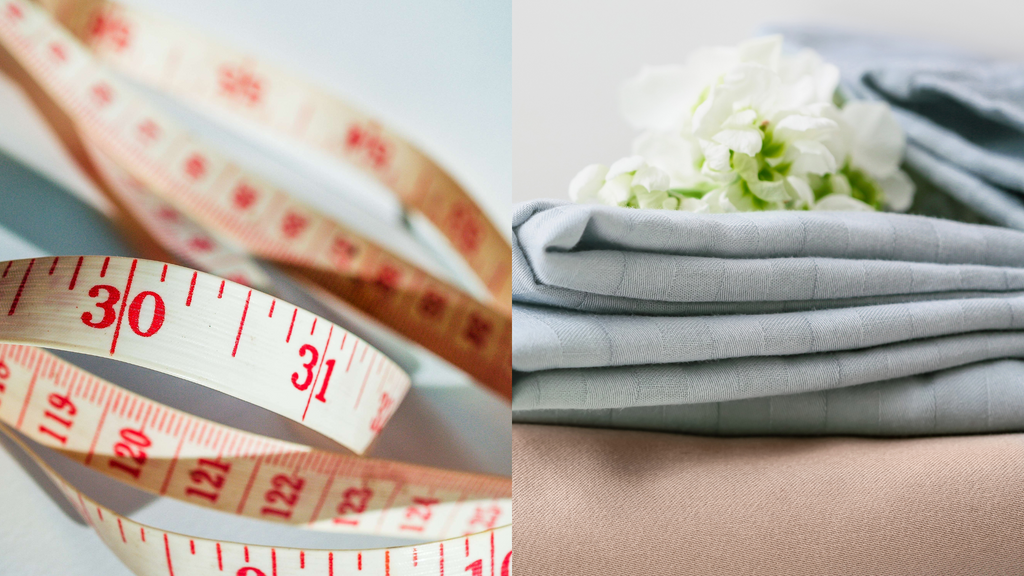Bedsheets play an important role in ensuring a good night's sleep. They're not just for decoration; they are a cosy barrier between you and your mattress. Imagine sleeping on a scratchy, uncomfortable surface every night – it wouldn't be pleasant at all. That is why understanding and choosing the right bedsheets is essential for your comfort and well-being.
Different Types of Bedsheets
Cotton Bedsheets
Cotton bedsheets are known for their natural, breathable properties. They are soft to the touch and come in various thread counts, which affect their texture and durability.
Pros: It offers breathability and comfort throughout the year, making it a superb choice for all seasons. It is durable, can withstand frequent washing, and is available in various styles and prices.
Cons: They are prone to wrinkling, so they may require ironing and can be expensive due to their high-quality cotton.
Linen Bedsheets
Linen sheets are made from flax fibres, giving them a textured, rustic appearance, and they are highly breathable and moisture-wicking, making them ideal for hot climates.
Pros: Exceptionally breathable and cool, making them perfect for summer and becoming softer and more comfortable with each wash. It is also naturally hypoallergenic and resistant to pests.
Cons: Tend to wrinkle easily, which some people find charming but others may not like. Also, it can be relatively expensive compared to other options.
Silk Bedsheets
Silk Bedsheets have a natural sheen and, are known for their temperature-regulating properties, and are luxurious and incredibly smooth to the touch.
Pros: Exceptionally soft and gentle on the skin, naturally temperature-regulating, keeps you cool in summer and warm in winter.
Cons: Expensive compared to other materials, require delicate care, and may not be as durable as cotton or linen.
Microfibre Bedsheets
Microfibre sheets are made from synthetic fibres that are extremely fine and tightly woven, which makes them budget-friendly.
Pros: Affordable and resistant to wrinkles and stains. Also, it is hypoallergenic and easy to care for.
Cons: It may not be as breathable as natural materials, potentially leading to heat retention.
Blended Fabrics
Blended bedsheets combine different materials, such as cotton-polyester blends. These sheets aim to combine the advantages of each material.
Pros: Can offer a balance of comfort, durability, and affordability. It is also less prone to wrinkling than pure cotton sheets.
Cons: It may not have the same breathability or natural feel as pure cotton or linen.
What is Thread Count in Bedsheet?

Thread count is a term you'll often encounter when shopping for bedsheets, and it's an essential factor to consider when assessing their quality. Thread count refers to the number of threads, horizontal (weft) and vertical (warp), woven into one square inch of fabric. It's usually listed as a two-number figure, such as "200 thread count."
Higher Thread Count
Many people believe that a higher thread count automatically indicates better-quality sheets. While it can be a factor, it's not the sole determinant of quality.
Lower Thread Count
Lower thread count sheets are not necessarily of lower quality. In some cases, they can be pretty comfortable and durable.
What are the Factors to Consider Regarding Thread Count
Fibre Quality
The quality of the fibres used in the sheets is crucial. High-quality fibres like long-staple cotton can produce soft and durable sheets, even with a moderate thread count.
Weave
The way the fabric is woven also affects its feel and durability. Percale and sateen weaves, for example, can influence how a lower thread count sheet feels.
Ply
Ply refers to the number of yarns twisted together to make a single thread. Single-ply sheets are often softer than double-ply sheets with the exact thread count.
Finish
The finish applied to the sheets can affect their texture and durability. Some finishes make sheets smoother, while others provide a crisp feel.
Pros and Cons of Different Thread Counts
Low Thread Count (200-400)
Pros: Breathable, calm, and lightweight. Ideal for warm sleepers and hot climates.
Cons: Less durable and may feel thinner.
Medium Thread Count (400-800)
Pros: Offers a balance between comfort and durability and is suitable for most climates.
Cons: It may not be as breathable as lower thread count sheets.
High Thread Count (800+)
Pros: It can feel incredibly soft and luxurious. It is also durable and long-lasting.
Cons: May retain heat, making them better suited for cooler climates.
Important Note: Your "best" thread count depends on your preferences and needs. Some people prefer the crisp feel of lower thread count sheets, while others enjoy the silky smoothness of higher thread counts. Also, when assessing sheet quality, consider factors beyond thread count, such as the type of fibre, weave, ply, and finish. These elements can significantly influence your sleeping experience.
Sizes and Measurements of Bedsheets

When buying bedsheets, getting the right size is crucial to ensure a snug fit, comfort, and an attractive appearance on your bed. Here, we'll explain the various sizes and measurements of bedsheets to help you choose the perfect fit for your mattress.
Single Bed
The single bed is suitable for one person and is a common choice for Singapore's children, teenagers, and single adults.
Dimensions: Approximately 91 cm (36 inches) wide and 190 cm (75 inches) long.
Super Single Bed
The super single bed provides more space than the standard single bed and is often chosen by teenagers and young adults.
Dimensions: Approximately 107 cm (42 inches) wide and 190 cm (75 inches) long.
Queen Bed
The queen bed is a popular choice for couples in Singapore, offering more space than a single or super single bed.
Dimensions: Approximately 152 cm (60 inches) wide and 190 cm (75 inches) long.
King Bed
The king bed is the largest standard size available and provides ample space for couples or those wanting extra room to spread out.
Dimensions: Approximately 182 cm (72 inches) wide and 198 cm (75 inches) long.
Important Note: It's important to note that while these are the standard bed sizes in Singapore, variations and custom sizes are also available, especially for imported mattresses. Additionally, some beds may have unique designs or dimensions, so measuring your mattress's exact dimensions is essential to ensure a proper fit when shopping for bedsheets.
Fitting Bedsheets Correctly
Fitting bedsheets correctly means ensuring that the sheets properly cover your mattress, stay in place, and provide a comfortable sleeping surface. It involves measuring both the width and length of your mattress and its depth. This way, you can select sheets with the appropriate pocket depth (the depth of the fitted sheet's corners) to accommodate your mattress. Properly fitted sheets look better and stay in place during the night, preventing them from slipping off.
Importance of Deep-Pocket Sheets for Thick Mattresses
Deep-pocket sheets are designed to fit thicker mattresses, including those with pillow tops, mattress toppers, or additional padding. The importance of deep-pocket sheets lies in their ability to provide a secure and snug fit on such mattresses. Regular sheets on thick mattresses may not cover the corners adequately and can pop off easily, leading to discomfort during sleep. Additionally, deep-pocket sheets, with their deeper corners, prevent this issue and ensure that the sheet stays in place. They are especially crucial for maintaining a tidy and well-made bed while accommodating thicker bedding setups, which are becoming increasingly common for added comfort.
Bedsheet FAQs
What is the importance of choosing the right bedsheets for my bed?
Bedsheets directly impact your sleep comfort and quality. The right sheets can enhance your sleep experience, while the wrong ones can lead to discomfort and poor sleep.
What’s the Difference Between Thread Count and Sheet Quality?
Thread count measures the number of threads per square inch, but it's not the only factor determining quality. Fibre quality, weave, ply, and finish also play important roles.
How Often Should I Wash My Bedsheets?
Washing your bedsheets every 1 to 2 weeks is recommended, but this can vary based on personal preferences, climate, and allergies. Spills or stains may require more frequent washing.
What’s the best material for bedsheets in hot climates?
In hot climates, breathable materials like cotton and linen are often preferred. They help regulate body temperature and keep you cool during the night.
How do I prevent my bedsheet from wrinkling?
To prevent wrinkles, promptly remove sheets from the dryer and fold them neatly. Wrinkle-resistant fabrics like microfiber can also be a good choice.
Are there eco-friendly options for bedsheets?
Yes, eco-friendly options include sheets made from sustainable materials like organic cotton, bamboo, and Tencel. Look for certifications like GOTS (Global Organic Textile Standard) for eco-friendly choices.
Are there specific bedsheets recommended for individuals with allergies?
Hypoallergenic bedsheets from materials like silk, bamboo, or high-quality cotton can benefit individuals with allergies. Regular washing is also important to remove allergens.
How do I care for silk bedsheets?
Silk bedsheets require gentle care. Hand wash or use a delicate cycle with cold water. Avoid direct sunlight and sharp objects that could damage the delicate fibres.
Conclusion
Bedsheets are not merely decorative but essential components of a comfortable and restful sleep environment. The diversity of materials, weaves, and sizes ensures a perfect choice for everyone, whether it's the breathability of cotton for hot summers or the luxurious softness of silk for a touch of luxury. With the proper knowledge, you can transform your bedtime routine into a cosy and luxurious experience, night after night.








